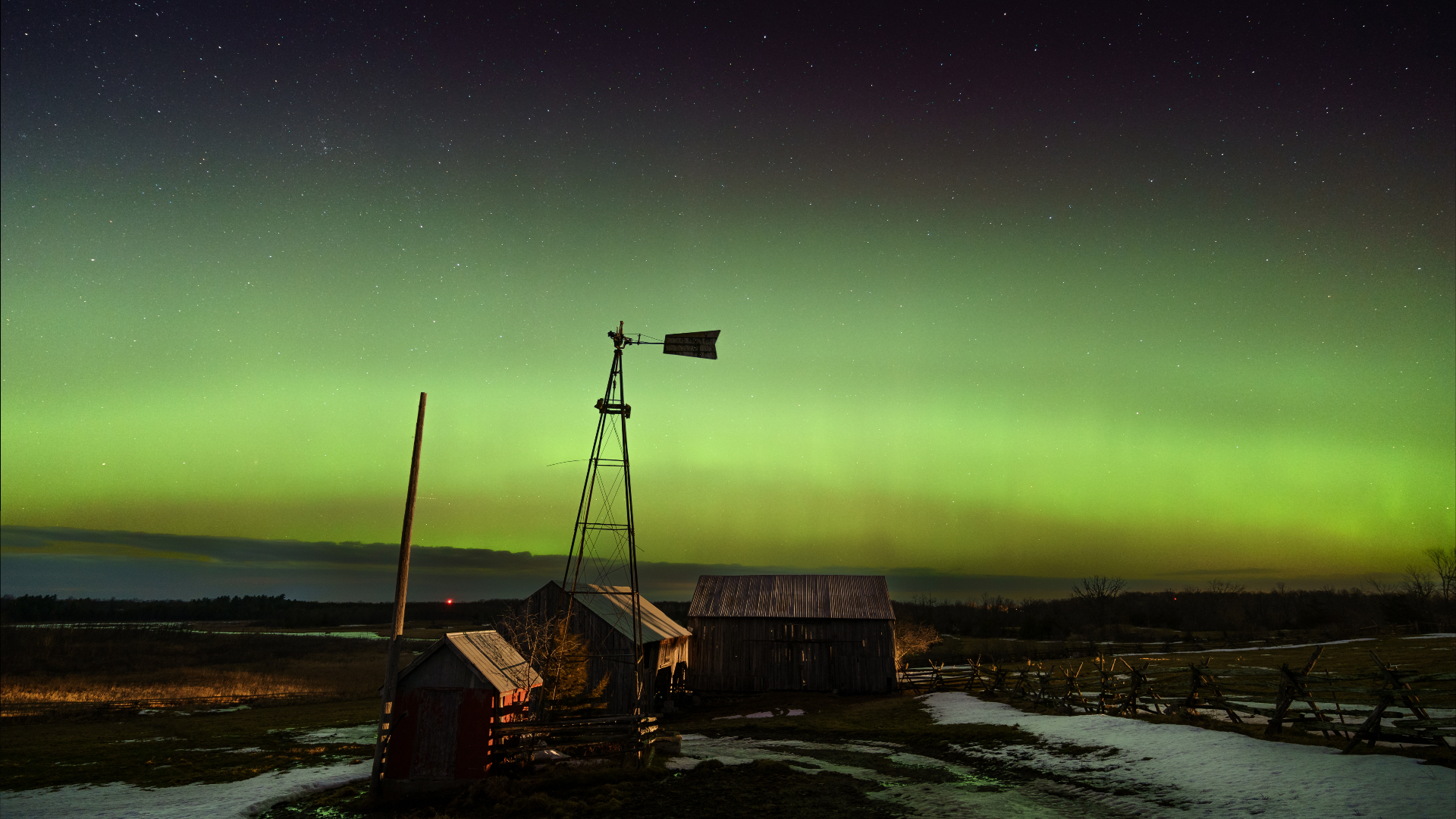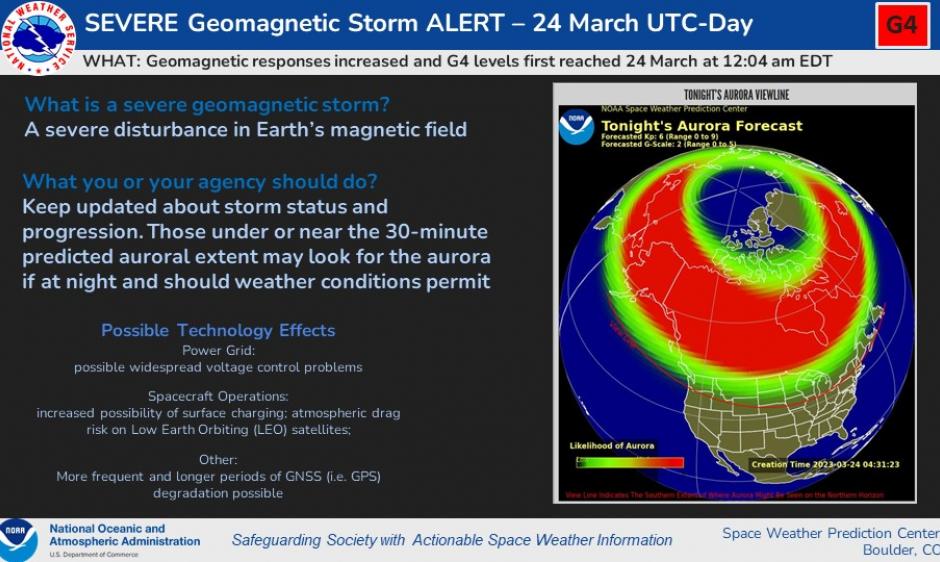Strongest solar storm in nearly 6 years slams into Earth catching forecasters by surprise
The powerful solar storm supercharged auroras as far south as Colorado and New Mexico.

The most powerful solar storm in nearly six years slammed Earth today (March 24), but strangely, space weather forecasters didn't see it coming.
The geomagnetic storm peaked as a severe G4 on the 5-grade scale used by the U.S. National Oceanic and Atmospheric Administration (NOAA) to assess the severity of space weather events. The storm's unexpected ferocity not only made auroras visible as far south as New Mexico in the U.S., but it also forced spaceflight company Rocket Lab to delay a launch by 90 minutes.
Geomagnetic storms are disturbances to Earth's magnetic field caused by solar material from coronal mass ejections (CME) — large expulsions of plasma and magnetic field from the sun's atmosphere. It turns out that this particular geomagnetic storm was triggered by a "stealth" CME which — as the name suggests — is rather tricky to detect.
Related: Huge solar tornado as tall as 14 Earths hurls plasma cloud into space. Here's the video.
NOAA's National Space Weather Service originally announced a "geomagnetic storm watch" on March 22, to come into effect on 23-25 March with possible moderate G2 storm conditions expected on March 24. So forecasters weren't completely caught off-guard, they however didn't expect a magnitude G4 storm.
It wasn't until 00:41 a.m. EDT ( 0441 GMT) on March 24 that NOAA uprated the warning to a severe G4 storm, which was after a stronger than forecasted G3 storm escalated to a G4 at 12:04 a.m. EDT (0404 GMT).

U.S. space weather forecaster Tamitha Skov explained to Space.com in an email why the space weather community got it so wrong with this latest storm.
Get the Space.com Newsletter
Breaking space news, the latest updates on rocket launches, skywatching events and more!
"These nearly invisible storms launch much more slowly than eruptive CMEs and are very difficult to observe leaving the sun's surface without specialized training," she said, adding that the stealth CMEs can also be "camouflaged" by other, more dense structures emanating from the sun, which makes them difficult to observe.
"This is why they are the cause of "problem geomagnetic storms" like the G4-level storm we are in now." Skov continued.
You can learn more about these stealthy solar storms in Skov's latest YouTube video where she describes the space weather event in more detail.
NOAA ranks geomagnetic storms on a scale running from G1, which could cause an increase in auroral activity around the poles and minor fluctuations in power supplies, up to G5, which includes extreme cases like the Carrington Event — a colossal solar storm that occurred September 1859, which disrupted telegraph services all over the world and triggered auroras so bright and powerful that they were visible as far south as the Bahamas.
Strong geomagnetic storms can be troublesome for spaceflight as they increase the density of gases in Earth's upper atmosphere, thereby increasing the drag on satellites and other spacecraft. In February 2022 SpaceX lost up to 40 brand-new Starlink satellites when they failed to reach orbit after being launched into a minor geomagnetic storm.
Rocket Lab delayed its launch this morning by approximately 90 minutes while assessing the evolving conditions of the geomagnetic storm, the company announced on Twitter. They successfully launched at 5:14 a.m. EDT (0914 GMT).
Another side effect of powerful geomagnetic storms is the incredible aurora displays they trigger. When energized particles from the sun slam into Earth's atmosphere at speeds of up to 45 million mph (72 million kph), our planet's magnetic field funnels the particles toward the poles. The ensuing supercharging of molecules in Earth's atmosphere triggers the colorful spectacles, which usually remain limited to areas at high latitudes. This time, skywatchers around the world were treated to a dazzling auroral display that reached as far south as Colorado and New Mexico.
We can expect more extreme space weather events like this powerful geomagnetic storm as the sun builds towards a peak in its 11-year solar activity cycle, expected to occur in 2025.
Join our Space Forums to keep talking space on the latest missions, night sky and more! And if you have a news tip, correction or comment, let us know at: community@space.com.

Daisy Dobrijevic joined Space.com in February 2022 having previously worked for our sister publication All About Space magazine as a staff writer. Before joining us, Daisy completed an editorial internship with the BBC Sky at Night Magazine and worked at the National Space Centre in Leicester, U.K., where she enjoyed communicating space science to the public. In 2021, Daisy completed a PhD in plant physiology and also holds a Master's in Environmental Science, she is currently based in Nottingham, U.K. Daisy is passionate about all things space, with a penchant for solar activity and space weather. She has a strong interest in astrotourism and loves nothing more than a good northern lights chase!
-
jaymay022616 How can it be a surprise to the scientist when I read on Tuesday that the sun had spewed out a massive discharge and that it would be here on 3/24 and mess with the Aurora borealis and the electromagnetic field? Are you just trying to get people to read your news? Or maybe your scientists didn't know it was coming and caught them by surprise?Reply -
Atlan0001 Since there are two articles pertaining to the same event, this applies here even more than where I originally posted it:Reply
Yep! A hundred to a thousand and more times the power of the 1859 "Carrington Event." We are just lucky, very lucky, it occurred, blew out, on the other side of the sun from us, or we would have been in a mess of a mass extinction event of our electronics, especially our computerized electronics, world-wide: Thus, the death of a good part of the world's population so dependent upon electronics for literally everything today; literally dependent for Civilization today, for life itself today. Symbiotic(!), if you will.
Yep, life needs to break out, expand out, from the Earth ASAP. Life needs to spread out into the -
bwana4swahili It was one of the best Aurora displays I've seen in the past couple of years.Reply
https://flic.kr/s/aHBqjAx2vC









